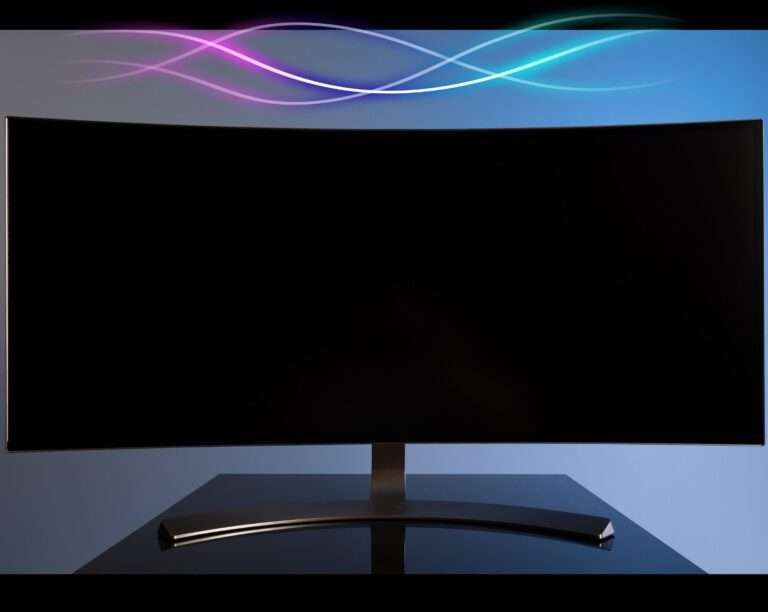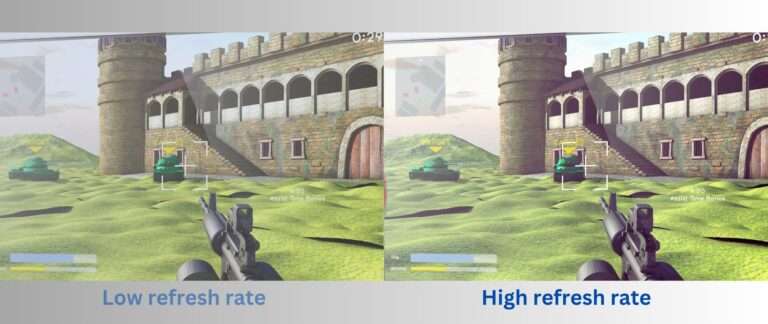
Are you thinking of upgrading to a newer version of the gaming monitor or want to understand the latest Gaming Monitor benefits? This article on New technologies in Gaming monitor in 2024 will be of immense value to you and will help you to get many insights which in turn will help you to make informed decisions. Even though new tech is advancing quickly, we may only see a few innovations like machine learning in gaming monitor in 2024. However, we might still see the use of AI and updated versions of some of the technologies that are being used currently.
Here are some of the new technologies in Gaming Monitors
Some of them are already available now however we can see a better version of them in 2024.
Mini-LED and Micro-LED offer various advantages over traditional LED-backlit monitors, including:
- Higher brightness: Mini-LED and Micro-LED backlighting allows for much higher brightness levels, which is ideal for HDR gaming.
- Better contrast: Mini-LED and Micro-LED backlighting also provides better contrast ratios, resulting in more realistic and vibrant images.
- More precise dimming: Mini-LED and Micro-LED can be dimmed more precisely than traditional LEDs, resulting in reduced blooming and halo effects.
- Lower power consumption: Mini-LED and Micro-LED backlighting is more energy-efficient than traditional LED backlighting, which can help to extend battery life on laptops and other mobile devices.
Just to update you, Micro-LED technology is still in its early stages of development and is not yet cost-effective for use in consumer products like gaming monitors. However, a number of companies are developing micro-LED displays, and we can expect to see them in gaming monitors in the next few years. However, we can expect to see more gaming monitors with Mini-LED backlighting in 2024.
2 HDR 10+ and Dolby Vision:
HDR 10+ and Dolby Vision are two competing HDR formats that offer improved image quality over standard HDR. HDR 10+ and Dolby Vision are used in a variety of devices, including gaming monitors, TVs, and smartphones. Both formats offer several benefits over traditional SDR content, including:
Higher brightness: HDR 10+ and Dolby Vision can display images with much higher brightness levels than SDR content. This can result in more realistic and immersive images, especially in games with bright scenes, such as sunlit landscapes or explosions.
Better contrast: HDR 10+ and Dolby Vision also offer better contrast ratios than SDR content. This means that dark and light areas of an image can be displayed more accurately, resulting in more depth and realism.
Wider color gamut: HDR 10+ and Dolby Vision support a wider color gamut than SDR content. This means that games can display a wider range of colors, resulting in more vibrant and realistic images.
In addition to these general benefits, HDR 10+ and Dolby Vision also offer some specific benefits for gaming monitors. For example, both formats can dynamically adjust the brightness and contrast of an image based on the content being displayed. This can help to improve the overall gaming experience by providing a more realistic and immersive image.
Examples of how HDR 10+ and Dolby Vision can improve the gaming experience:
- In a racing game, HDR 10+ or Dolby Vision can make the cars and tracks look more realistic by displaying them with brighter headlights and more vibrant colors.
- In a first-person shooter, HDR 10+ or Dolby Vision can make the enemies and environments look more realistic by displaying them with more detail and depth.
- In a role-playing game, HDR 10+ or Dolby Vision can make the world look more immersive by displaying it with more vibrant colors and more realistic lighting effects.
Overall, HDR 10+ and Dolby Vision can offer a number of benefits for gaming monitors. Both formats can improve the overall gaming experience by providing a more realistic and immersive image.
If you are looking for a new gaming monitor, we recommend considering a monitor that supports HDR 10+ or Dolby Vision. These formats can offer a significant improvement in image quality, especially in games with bright scenes, detailed environments, and vibrant colors.
Currently, only a few gaming monitors are available with HDR 10+ and Dolby Vision. We can expect to see more gaming monitors with HDR 10+ and Dolby Vision support in 2024.
3 Higher refresh rates and resolutions:

Gaming monitors with higher refresh rates and resolutions are becoming increasingly popular. Gaming monitors with 240Hz refresh rates and 4K and 8K resolutions offer a number of benefits, including smoother gameplay, sharper images, reduced eye strain, and a competitive edge. However, they can be very expensive and require a powerful graphics card to drive games at these high refresh rates and resolutions.
We can expect to see more gaming monitors with refresh rates of 240Hz and higher, and resolutions of 4K and 8K, in 2024.
4 Variable refresh rates (VRR):
VRR technologies, such as NVIDIA G-SYNC and AMD FreeSync, can help to eliminate tearing and stuttering in games. Variable refresh rates (VRR) are a technology that allows a display to adjust its refresh rate to match the frame rate of the content being displayed. This can help to reduce screen tearing and stuttering, which can be especially noticeable in demanding games.
Given below are the benefits of VRR:
Reduced input lag: VRR can help to reduce input lag by reducing the amount of time it takes for the display to refresh. This can give players a competitive edge in games where every millisecond counts.
Reduced eye strain: VRR can help to reduce eye strain by reducing screen tearing and stuttering. This can make it more comfortable to play games for longer periods.
Improved image quality: VRR can help to improve image quality by reducing screen tearing and stuttering. This can make games look more realistic and immersive.
VRR can be especially beneficial in demanding games because it can help to improve the overall gaming experience by providing smoother and more responsive gameplay.
Examples of how VRR can improve the gaming experience in demanding games:
- In a racing game, VRR can make the game feel more realistic and immersive.
- In a first-person shooter, VRR can give players a competitive edge by allowing them to see their enemies more clearly.
- In a role-playing game, VRR can make the game feel more cinematic and immersive.
Overall, VRR is a valuable technology for gamers, especially those who play demanding games. It can help to improve the overall gaming experience by providing a smoother and more responsive gameplay.
If you are looking for a way to improve your gaming experience, we recommend considering a monitor that supports VRR. VRR is a valuable technology for those who play demanding games.
We can expect to see more gaming monitors with VRR support in 2024.
5 Curved displays:
Curved displays make gaming feel even more real. Given below are the benefits of gaming monitors with Curved displays:
Increased immersion: Curved displays can provide a more immersive gaming experience by wrapping around the player’s field of view. This can make players feel more like they are part of the game world and can help to improve their overall gaming experience.
Reduced eye strain: Curved displays can help to reduce eye strain by reducing the amount of head movement required to see the entire screen. This can really help out gamers who like to play for a long time.
Improved viewing angles: Curved displays offer better viewing angles than traditional flat displays. This means that players can still see a clear image even if they are not sitting directly in front of the monitor.
Reduced distortion: Curved displays can help to reduce distortion and improve the overall image quality. This can make games look more realistic and immersive.
Examples of how curved displays can improve the gaming experience:
- In a racing game, a curved display can make the player feel more like they are sitting in the driver’s seat.
- In a first-person shooter, a curved display can give players a wider field of view, which can help them to see their enemies more easily.
- In a role-playing game, a curved display can make the world feel more immersive by wrapping around the player’s field of view.
6 Quantum dot (QD) technology:
QD technology is expected to be used in more gaming monitors in 2024. We can also expect QD-OLED, this will be a new type of OLED display that combines the advantages of OLED displays with the advantages of QD displays.
QD technology has several benefits for gaming monitors, including:
Improved color gamut: QD technology can significantly improve the color gamut of displays, which means that QD gaming monitors can display a wider range of colors than traditional gaming monitors. This can result in more realistic and vibrant colors in games.
Increased brightness: QD technology can also increase the brightness of displays, which makes QD gaming monitors ideal for HDR gaming.
Improved contrast: QD technology can also improve the contrast ratio of displays, which results in deeper blacks and brighter whites. This can make games look more realistic and immersive.
Reduced blooming: QD technology can also reduce blooming, which is a common problem with HDR displays. Blooming occurs when bright objects in a scene cause the surrounding areas to appear brighter than they should. QD technology can help to reduce blooming and improve the overall image quality of HDR games.
7 HDMI 2.1a support:
HDMI 2.1a is expected to be released in 2024, HDMI 2.1a will be the latest version of the HDMI standard, and it will offer a range of benefits for gaming, including:
Support for higher refresh rates and resolutions: HDMI 2.1a will be capable of handling resolutions up to 10K and refresh rates up to 240Hz. This will allow gamers to enjoy higher resolutions and smoother refresh rates, creating a more immersive gaming experience.
Support for VRR and ALLM: HDMI 2.1a will support Variable Refresh Rate (VRR) and Auto Low Latency Mode (ALLM). VRR will eliminate screen tearing and stuttering by syncing the display’s refresh rate with the content’s frame rate. ALLM will automatically enable low-latency mode when gaming, reducing input lag.
Support for HDR10+ and Dolby Vision: HDMI 2.1a will also support competing HDR formats, HDR10+ and Dolby Vision. These formats will deliver more realistic and vibrant visuals with enhanced brightness, deeper blacks, and a broader color spectrum.
Support for eARC: Enhanced Audio Return Channel (eARC) will be a feature of HDMI 2.1a.
eARC will be able to transmit uncompressed audio formats, like Dolby Atmos and DTS:X, from the gaming monitor to the soundbar or AV receiver. This will enhance the gaming experience, providing a more immersive and lifelike audio ambience during gameplay. Additionally, eARC will reduce latency between the gaming monitor and the soundbar or AV receiver, ensuring that the audio synchronizes seamlessly with the on-screen visuals. Furthermore, eARC will allow a simplified setup by enabling a direct connection from the gaming monitor to the soundbar or AV receiver using a single HDMI cable, effectively reducing cable clutter and streamlining the overall setup process.
Overall, the gaming monitor market is constantly evolving, and we can expect to see a number of new technologies in gaming monitor in 2024. We anticipate that, by 2024, many of these technologies with higher versions, if not all, will be integrated into gaming monitors, elevating the immersive gaming experience to the next level.
We appreciate your presence throughout this article. Please share your thoughts and comments. If you found this content valuable, consider sharing it with friends and on your social media platforms
